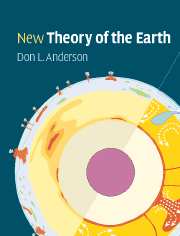Book contents
- Frontmatter
- Contents
- Preface and Philosophy
- Abbreviations and acronyms
- Part I Planetary perspective
- Chapter 1 Origin and early history
- Chapter 2 Comparative planetology
- Chapter 3 The building blocks of planets
- Part II Earth: the dynamic planet
- Part III Radial and lateral structure
- Part IV Sampling the Earth
- Part V Mineral physics
- Part VI Origin and evolution of the layers and blobs
- Part VII Energetics
- References and notes
- Appendix
- Index
Chapter 1 - Origin and early history
Published online by Cambridge University Press: 05 June 2012
- Frontmatter
- Contents
- Preface and Philosophy
- Abbreviations and acronyms
- Part I Planetary perspective
- Chapter 1 Origin and early history
- Chapter 2 Comparative planetology
- Chapter 3 The building blocks of planets
- Part II Earth: the dynamic planet
- Part III Radial and lateral structure
- Part IV Sampling the Earth
- Part V Mineral physics
- Part VI Origin and evolution of the layers and blobs
- Part VII Energetics
- References and notes
- Appendix
- Index
Summary
Earth is the namesake of the terrestrial planets, also known as the inner or rocky planets. The chemistry of meteorites and the Sun provide constraints on the composition of the bulk of these planets and they provide tests of theories of planetary formation and evolution. In trying to understand the origin and structure of the Earth, one can take the geocentric approach or the ab initio approach. In the former, one describes the Earth and attempts to work backward in time. For the latter, one attempts to track the evolution of the solar nebula through collapse, cooling, condensation and accretion, hoping that one ends up with something resembling the Earth and other planets. Planets started hot and had a pre-history that cannot be ignored. The large-scale chemical stratification of the Earth reflects accretionary processes.
Condensation of the nebula
The equilibrium assemblage of solid compounds that exists in a system of solar composition depends on temperature and pressure and, therefore, location and time. The condensation behavior of the elements is given in Figures 1.1 and 1.2.
At a nominal nebular pressure of 10−1 atm, the material would be a vapor at temperatures greater than about 1900 K. The first solids to condense at lower temperature or higher pressure are the refractory metals (such as W, Re, Ir and Os). Below about 1750 K refractory oxides of aluminum, calcium, magnesium and titanium condense, and metallic iron condenses near 1470 K (Table 1.1 and Figure 1.2).
- Type
- Chapter
- Information
- New Theory of the Earth , pp. 3 - 11Publisher: Cambridge University PressPrint publication year: 2007
- 1
- Cited by



